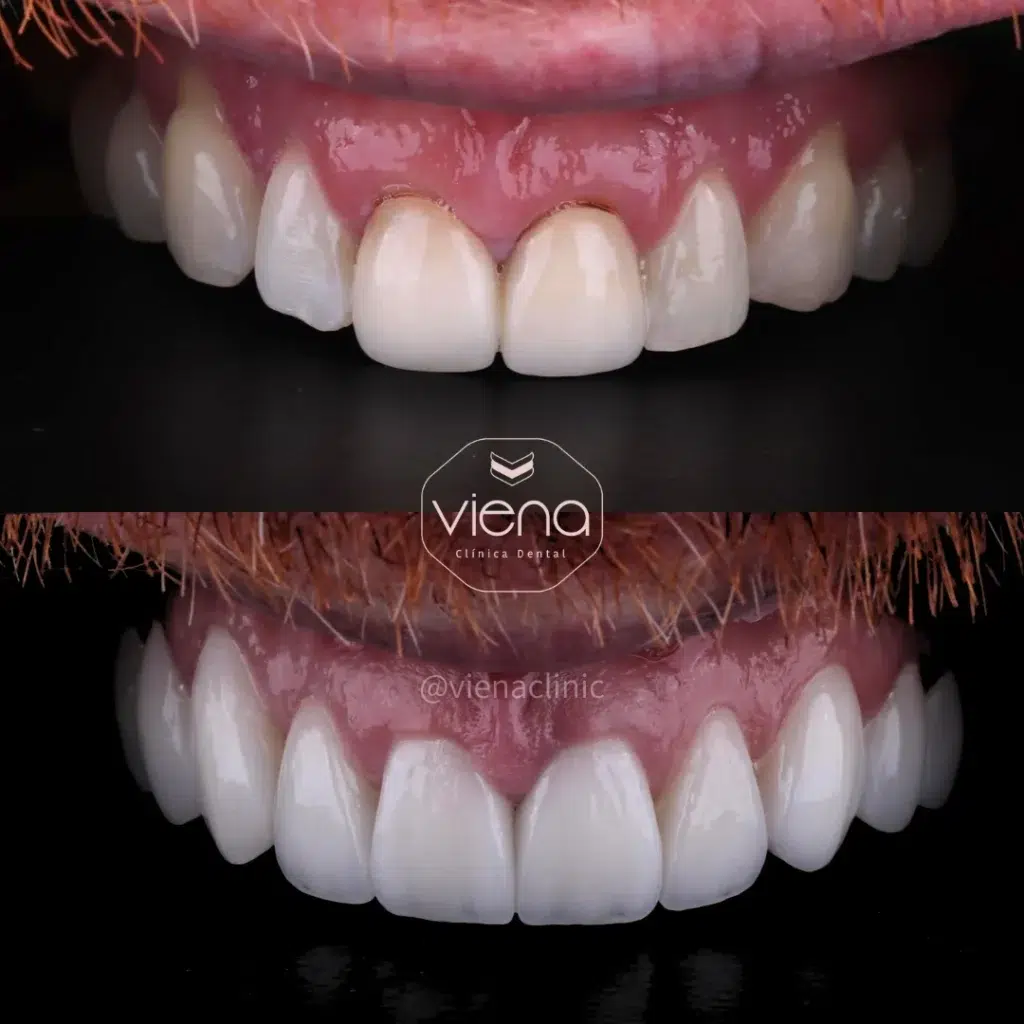Contenido:
TogglePorcelain veneers can last over 10 years—with studies showing a 95% survival rate at the decade mark. Their durability depends on proper planning, bite alignment, and good habits. Composite veneers, meanwhile, last around 5 years and may need replacement sooner due to staining or chipping.
When it comes to achieving that dazzling smile, one of the most common questions I hear is, “How long do veneers last?” Well, my friends, the answer isn’t as straightforward as you might hope. The lifespan of dental veneers can vary significantly based on a few key factors: the material used (porcelain vs composite), your oral habits, and how well the case was planned from the get-go.
Let’s dive into the nitty-gritty! Research shows that porcelain veneers boast an impressive survival rate of over 95% after a decade. Yes, you read that right-ten whole years of confidence in your smile! In general, more than 90% of these beauties hold up beautifully over time. But here’s a fun fact: minimal or no-prep veneers, which preserve that precious enamel layer, have even higher success rates.
But hold onto your toothbrushes! The most common culprit for veneer failure? Fractures-often caused by bruxism (that’s fancy talk for grinding your teeth) or poor occlusal planning. It’s like playing a game of Jenga; if you don’t stack those blocks just right, it all comes tumbling down!
Now let’s talk about bonding. Immediate dentin sealing is a game-changer when it comes to enhancing bond strength whenever dentin is exposed. Think of it like putting on a raincoat before stepping out into a storm-it keeps everything nice and dry!
And while porcelain shines bright in terms of longevity and durability, composite veneers typically last around five years. They’re great for a quick fix but come with their own set of challenges: discoloration, marginal staining, porosity-you name it! Most patients find themselves replacing them due to aesthetic concerns rather than functional ones.
So what does this all mean for you? The key to ensuring your veneers stand the test of time isn’t just about the material; it’s also about custom planning, choosing the right clinic (hello, Clinica Viena!), and maintaining good oral hygiene habits. While no treatment lasts forever-sorry to burst that bubble-making informed decisions backed by science can certainly pave the way for long-term success!
Understanding Veneer Materials

When it comes to the question of how long do veneers last, understanding the materials that make up these dental wonders is crucial. The two main contenders in the veneer ring are porcelain and composite. Each has its own set of characteristics, benefits, and drawbacks that can significantly affect their lifespan.
Types of veneers: Porcelain vs. Composite
Let’s break it down like a science fair project! Here’s a quick overview:
| Type of Veneer | Lifespan | Durability | Aesthetic Appeal | Caring Requirements |
|---|---|---|---|---|
| Porcelain Veneers | 10-15 years | High | Very Natural | Regular dental care required |
| Composite Veneers | 5-7 years | Moderate | Good but less natural than porcelain | More frequent touch-ups needed |
This table lays out the basic comparison between porcelain and composite veneers, but let’s dig deeper into their unique characteristics!
Characteristics of porcelain veneers
Pearls of Wisdom:
- Lifespan: Typically last between 10-15 years, depending on various factors.
- Durability: Highly resistant to wear and tear, making them less likely to crack or chip.
- Aesthetic Appeal: Mimics natural tooth enamel beautifully, providing a stunning finish.
- Caring Requirements: While they are durable, they still need regular maintenance and good oral hygiene practices.
- Bonding Strength: Enhanced by techniques like immediate dentin sealing, which boosts bond strength when dentin is exposed.
The durability of porcelain veneers makes them a favorite among those seeking long-term solutions for smile enhancement. With proper care and regular check-ups, their longevity can truly shine!
Characteristics of composite veneers
The Quick Fix:
- Lifespan: Generally last about 5-7 years.
- Durability: More prone to staining and wear compared to porcelain options.
- Aesthetic Appeal:: Can look good initially but may discolor over time.
- Caring Requirements:: Require more frequent touch-ups due to potential for chipping or discoloration.
If you’re looking for a quick solution or a more budget-friendly option, composite veneers can be an appealing choice. However, remember that they may not stand the test of time as well as their porcelain counterparts!
The average lifespan of dental veneers varies significantly based on material choice: porcelain typically lasts longer than composite. Understanding these differences is key when considering your options!
The durability of veneers also depends heavily on individual factors like oral hygiene habits and lifestyle choices (hello, coffee lovers!). Regular check-ups with your dentist can help keep your smile in tip-top shape-think of it as your veneer insurance policy!
This understanding leads us to an essential question: Do veneers last forever?. The answer is no; however, with proper care and maintenance, you can significantly extend their longevity.
Caring for dental veneers in Colombia’s climate? It’s crucial! Humidity levels can impact how well your veneers hold up over time. The best practices for extending veneer life include avoiding hard foods that could cause fractures and maintaining good oral hygiene habits-think brushing twice daily and flossing like a pro!
If you’re ever wondering when do veneers need replacing?, keep an eye out for signs such as discoloration or chipping. Regular visits to your dentist will help identify any issues before they become major problems.
The bottom line? Whether you opt for porcelain or composite veneers, understanding the characteristics of each material will empower you to make informed decisions about your smile journey. So arm yourself with knowledge because when it comes to achieving that perfect grin, knowledge is power!
The Longevity of Porcelain Veneers
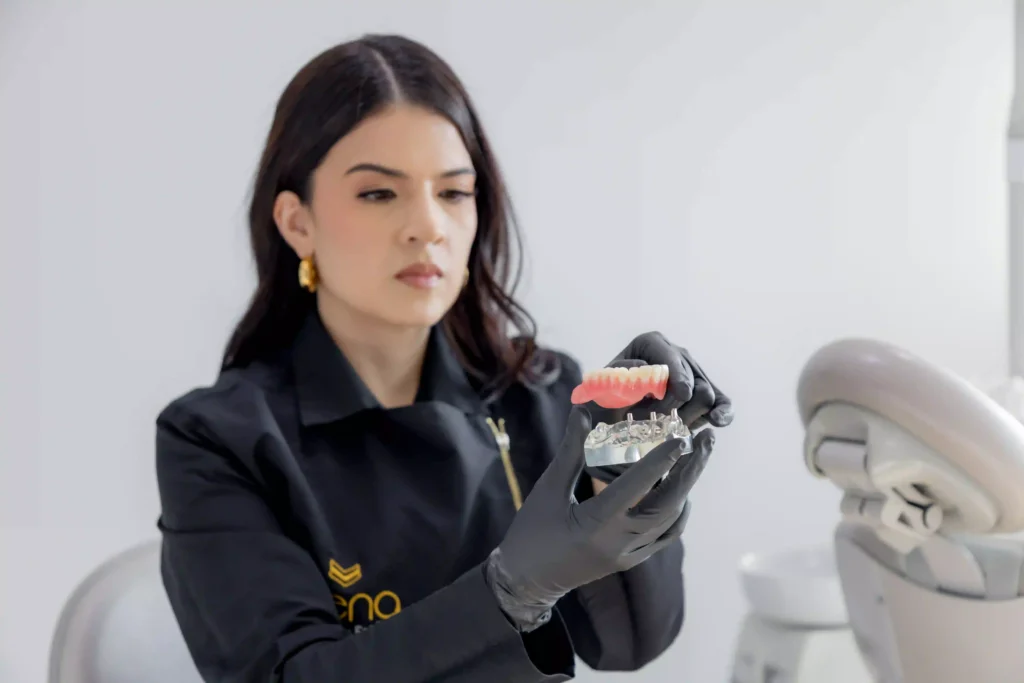
When diving into the question of how long do veneers last, it’s essential to understand the specifics surrounding their durability. Porcelain veneers, in particular, have become a popular choice for those looking to enhance their smiles. But just how long can you expect them to last? Spoiler alert: it’s quite impressive!
Survival rates based on recent literature reviews
Recent studies have shown that the lifespan of dental veneers, especially porcelain ones, is nothing short of remarkable. According to literature reviews, porcelain veneers boast an impressive survival rate of over 95% after 10 years. That’s like a superhero cape for your teeth-strong and reliable! More than 90% of these beauties hold up beautifully over time, making them a solid investment for your smile.
But wait, there’s more! Minimal or no-prep veneers-those that preserve your precious enamel-have even higher success rates. It’s like finding a secret level in a video game; you just get extra points for keeping your enamel intact!
Statistics: Over 95% survival after 10 years
Let’s break down those numbers a bit further:
- 10-Year Survival Rate: Over 95% for porcelain veneers.
- General Longevity: More than 90% remain intact beyond a decade.
- No-Prep Veneers: Higher success rates due to enamel preservation.
This data underscores how durable and reliable porcelain veneers can be when properly maintained. It’s like having the best insurance policy for your smile!
Success rates of minimal or no-prep veneers
If you’re considering veneers but are worried about damaging your enamel, fear not! Minimal or no-prep veneers are designed specifically to minimize this risk while still providing stunning results. They often come with even better success rates compared to traditional options. It’s like getting the benefits of a gym membership without having to step foot inside-you still get fit without all the sweat!
The secret sauce here is in the bonding techniques used during application. By preserving your enamel, these types of veneers offer enhanced longevity and are less prone to complications down the line.
Common reasons for failure: Fractures and bruxism
No journey is without its bumps, and veneer longevity is no exception. The most common culprits behind veneer failure include fractures and bruxism (fancy dentist-speak for grinding your teeth). Think of it this way: if you’re playing Jenga and someone keeps yanking out blocks from the bottom, eventually it all comes crashing down!
The most frequent reason for veneer failure? Fractures caused by bruxism or improper occlusal planning.
This means that if you’re someone who grinds their teeth at night or doesn’t have optimal bite alignment, it could spell trouble for those beautiful porcelain fronts. So what can you do? Addressing these habits early on can significantly improve your chances of maintaining those pearly whites over time.
Additionally, immediate dentin sealing plays a crucial role in enhancing bond strength when dentin is exposed during application. It’s like putting on a raincoat before stepping out into a storm-it keeps everything nice and dry!
Avoiding issues related to fractures not only requires proper planning but also regular visits to your dentist. Think of it as routine maintenance for your car; keeping everything in check ensures smooth sailing (or smiling) ahead!
Lifespan of composite veneers duration
If you’re curious about composite veneers, let’s spill some tea on their expected lifespan! Generally speaking, composite veneers tend to last around five years-definitely shorter than their porcelain counterparts. They serve as excellent quick fixes but come with some challenges:
- Discoloration: They are more prone to staining over time.
- Pores & Marginal Staining:: Their porous nature leads to potential discoloration around edges.
- Losing Shine:: They may lose their luster faster than porcelain options.
This means that many patients find themselves replacing composite veneers due more often due to aesthetic concerns rather than functional issues. It’s like getting excited about that new phone only to realize it looks old after just a year!
The takeaway? If you’re looking for longevity in your dental investment, opting for porcelain might be the way to go-especially if you’re looking at long-term results!
Caring for dental veneers in Colombia’s climate
If you’re considering getting dental work done while enjoying Colombia’s beautiful landscapes, keep in mind that local climate conditions can impact veneer durability too! Humidity levels may affect how well your materials hold up over time.
- Avoid hard foods that could cause fractures.
- Maintain good oral hygiene habits: Brush twice daily and floss like a pro!
If you’re ever wondering how often to replace veneers?, keep an eye out for signs such as discoloration or chipping during regular check-ups with your dentist-it’s like having an annual health check-up but for your smile!
The Science Behind Veneer Durability
Alright, my dental adventurers, let’s dive deep into the science behind veneer durability! You might be wondering, “How long do veneers last?”, and while it’s a great question, the answer is a bit like trying to catch smoke with your bare hands-it all depends on several key factors! Let’s break it down, shall we?
The role of immediate dentin sealing in bond strength
First up on our science tour is immediate dentin sealing. This technique is like giving your veneers a superhero cape before they even take flight! When dentin is exposed during veneer placement, using immediate dentin sealing can significantly enhance bond strength. Think of it as applying a protective barrier that keeps moisture and bacteria at bay-kind of like wearing a raincoat when you know the forecast calls for showers!
This method not only improves adhesion but also reduces the risk of complications down the line. By ensuring that your veneers are securely bonded to your teeth from the get-go, you’re setting yourself up for success. It’s like laying a solid foundation before building your dream house-without it, things could get shaky!
Material properties: E-max and glass ceramics advantages
Now let’s talk materials! When considering the durability of veneers, two heavyweights come into play: E-max and glass ceramics. These materials are like the Avengers of the dental world-each has unique superpowers that contribute to overall veneer longevity.
- E-max: Known for its exceptional strength and aesthetic appeal, E-max offers excellent color stability and fracture resistance. It’s like having a bodyguard who also knows how to throw a fabulous party!
- Glass Ceramics: These materials provide similar benefits with added translucency that mimics natural tooth enamel beautifully. They’re perfect for those looking to achieve that flawless smile without compromising on durability.
The combination of these advanced materials with proper resin cementation ensures that your veneers not only look stunning but also withstand the test of time. Remember: quality matters when it comes to achieving that dazzling grin!
The impact of proper resin cementation and hygiene on longevity
Last but certainly not least in our exploration is the impact of proper resin cementation and maintaining good oral hygiene habits. Just like you wouldn’t drive a car without regular maintenance checks, your veneers need some TLC too!
- Resin Cementation: The type of resin used during application plays a crucial role in how well your veneers hold up against wear and tear. High-quality cements create stronger bonds, meaning fewer worries about chips or cracks down the road.
- Oral Hygiene: Maintaining good oral hygiene habits is vital for keeping those pearly whites intact. Regular brushing, flossing, and dental check-ups help prevent issues like plaque buildup or gum disease that could compromise veneer integrity.
The takeaway here? Your daily habits can significantly influence how long veneers stay intact! Invest time in caring for them as if they were precious gems-and they’ll shine bright for years to come!
If you find yourself pondering how long do veneers last, remember this: while porcelain options generally boast an impressive lifespan of 10-15 years or more with proper care, composite versions typically clock in around 5 years due to various challenges such as discoloration and wear.
This means choosing high-quality materials paired with expert application techniques can pave the way toward extended veneer longevity! So whether you’re sipping coffee on a sunny patio in Colombia or enjoying some street tacos back home, knowing how to care for your investment will keep your smile radiant.
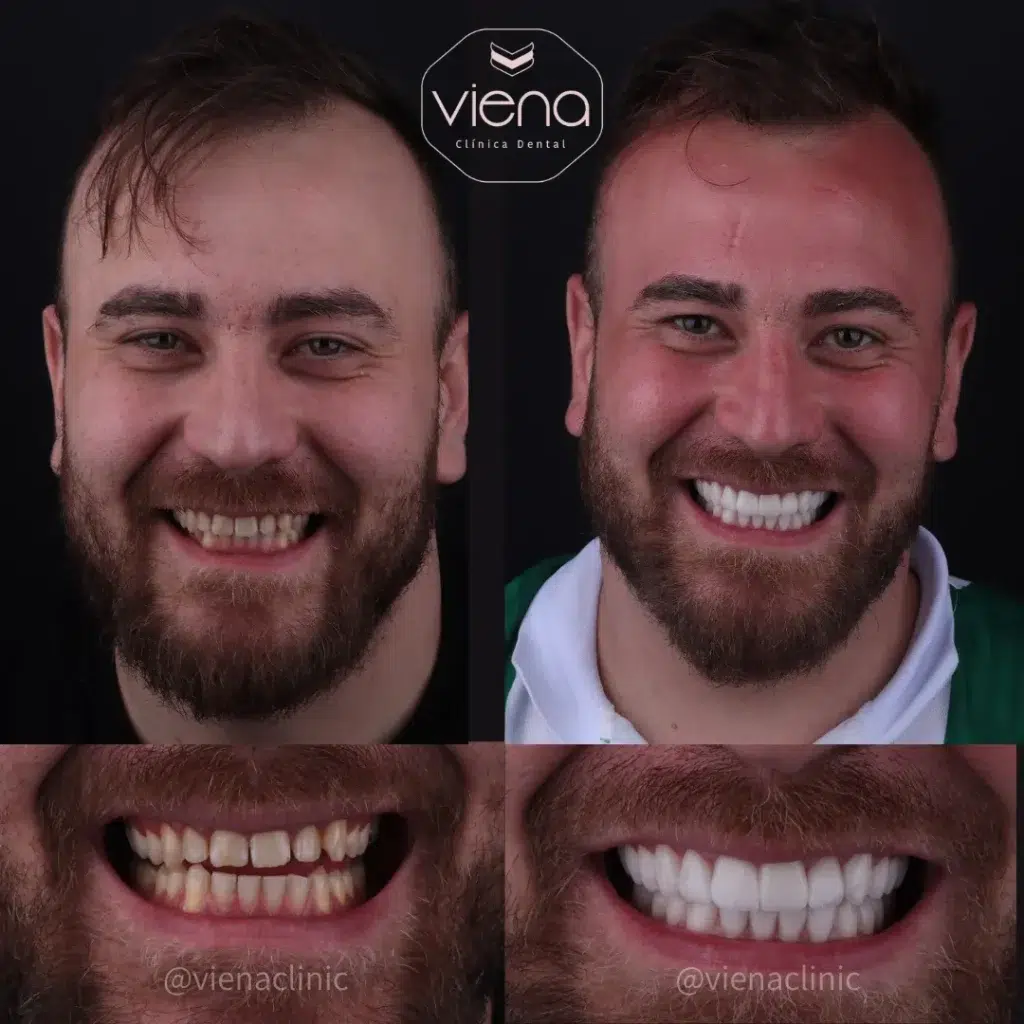
The Lifespan of Composite Veneers
Alright, let’s get down to the juicy details about the lifespan of dental veneers, specifically the composite kind! If you’ve ever wondered how long do veneers last, you’re not alone. Composite veneers are a popular choice for a quick smile fix, but their longevity might surprise you-spoiler alert: it’s not as long as their porcelain counterparts!
Averages: Typical lifespan around 5 years
On average, you can expect composite veneers to last around five years. Yes, you heard that right-five whole years of dazzling smiles before they start showing signs of wear and tear. Think of them as that trendy outfit you love but know won’t survive more than a few seasons. They’re great for a quick boost in confidence, but if you’re after something long-lasting, you might want to consider porcelain instead.
Why just five years? Well, composite veneers are prone to a few common issues:
- Discoloration: Over time, they can stain and lose their initial luster. If you’re a coffee or red wine lover, your veneers might start looking more like a watercolor painting than the bright smile you envisioned.
- Marginal Staining: The edges can become discolored due to plaque buildup or staining from food and drinks. It’s like wearing white sneakers; they look fresh at first but quickly show every little scuff!
- Pores & Porosity: Being more porous than porcelain means they absorb stains more easily. It’s like having a sponge for a tooth cover-great at soaking up color but not so great for keeping that pristine look.
- Losing Shine: They may lose their shine faster than porcelain options do, making them appear dull over time.
- Fractures: Composite is less resistant to fractures compared to porcelain. So if you’re biting into something hard or grinding your teeth at night (hello bruxism!), you could end up with some chips.
This means many patients end up replacing composite veneers sooner rather than later-not because they stop functioning but because they no longer look fabulous!
Main issues faced by composite veneers:
The takeaway? While composite veneers can give you an instant smile upgrade, be prepared for potential replacements every few years due to aesthetic concerns rather than functional failures.
Discoloration and marginal staining
If there’s one thing that’s almost inevitable with composite veneers, it’s discoloration. As we’ve mentioned before, these beauties are like sponges when it comes to absorbing stains from food and beverages. Over time, even regular brushing may not save them from looking less-than-stellar.
The phenomenon known as marginal staining occurs where the veneer meets the tooth surface. This area can trap plaque and bacteria, leading to discoloration that makes it look like your smile has seen better days. It’s akin to that pesky dirt line that appears on your favorite white sneakers after just one outing!
Poor resistance to fractures and loss of shine
The durability of composite veneers is another area where they fall short compared to porcelain options. They tend to chip or fracture more easily-especially if you’re someone who enjoys chewing ice or has bruxism (grinding your teeth). Think of them as the delicate flowers in your garden; while beautiful, they require extra care and attention!
Additionally, over time these veneers can lose their shine due to wear and tear from everyday use. That glossy finish you fell in love with initially? It might fade faster than you’d expect! Regular polishing at the dentist can help maintain their appearance-but this adds another layer of maintenance.
If you’re considering getting composite veneers, keep in mind their average lifespan is around five years with proper care-but be prepared for possible replacements sooner due to aesthetic concerns!
Caring for dental veneers in Colombia’s climate
If you’re planning on getting dental work done while enjoying Colombia’s beautiful landscapes (and affordable treatment!), consider how local climate conditions might impact veneer durability too! Humidity levels may affect how well your materials hold up over time.
- Avoid hard foods that could cause fractures.
- Maintain good oral hygiene habits: Brush twice daily and floss like a pro!
If you’re ever wondering how often to replace veneers?, keep an eye out for signs such as discoloration or chipping during regular check-ups with your dentist-it’s like having an annual health check-up but for your smile!
Comparative Analysis: Porcelain vs. Composite Veneers
So, you’ve decided to embark on your journey to a dazzling smile, but now you’re faced with a crucial question: Porcelain or Composite? Understanding the differences between these two materials is key to answering the ever-pressing question of how long do veneers last. Let’s break it down like a friendly neighborhood dentist would!
Functional vs. Aesthetic Concerns for Patients
When it comes to choosing between porcelain and composite veneers, patients often find themselves weighing functional benefits against aesthetic desires. Think of it as choosing between a reliable sedan and a flashy sports car-both have their perks, but they serve different purposes!
- Porcelain Veneers: These beauties are like the luxury sedans of the dental world-durable, reliable, and oh-so-sleek! They offer an impressive lifespan of 10-15 years with proper care. Their durability means less worry about wear and tear, making them ideal for those who grind their teeth or have an active lifestyle.
- Composite Veneers: On the flip side, composite veneers are more like that flashy sports car-great for quick fixes but not necessarily built for the long haul. With an average lifespan of around 5 years, they’re perfect if you want something that looks good right now but may need replacing sooner due to aesthetic concerns.
The choice often boils down to what you value more: longevity or immediate aesthetic appeal. If you want something that stands the test of time while still looking fabulous, porcelain is your best bet. But if you’re looking for a quick smile upgrade and are okay with potential replacements every few years, composite might just be your jam!
Cost Considerations for Different Materials
Now let’s talk dollars and cents! Cost is often a significant factor in deciding between porcelain and composite veneers. Here’s how they typically stack up:
| Type of Veneer | Average Cost (per veneer) | Lifespan | Caring Requirements |
|---|---|---|---|
| Porcelain Veneers | $1,000 – $2,500 | 10-15 years | Regular dental care required; less frequent replacements needed. |
| Composite Veneers | $250 – $1,500 | 5-7 years | More frequent touch-ups needed; higher chance of replacement due to discoloration. |
The upfront cost might make porcelain seem like a hefty investment compared to composite options; however, consider this: over time, those lower-cost composites may end up costing you more in replacements and maintenance! It’s like buying cheap shoes that wear out quickly versus investing in quality footwear that lasts for years.
The takeaway? While porcelain veneers come with a higher initial price tag, their longevity and durability can save you money in the long run. Think about what matters most to you before making your decision!
If you’re traveling to Colombia for dental work at Clinica Viena, remember that prices can be significantly lower than in the U.S., making it an excellent opportunity to invest in quality care without breaking the bank!
Your choice between porcelain and composite veneers ultimately boils down to your lifestyle needs and aesthetic preferences. Whether you lean towards the robust reliability of porcelain or the quick fix offered by composites, understanding their differences will help pave the way for a brighter smile ahead!
The Importance of Custom Planning and Maintenance
When it comes to the question of how long do veneers last, the answer is not just about the material used. It’s also about how well you plan your treatment and maintain your veneers afterward. Think of it like building a house: if you don’t have a solid foundation or if you neglect maintenance, that beautiful structure won’t stand for long!
Choosing the Right Clinic for Personalized Care
First things first: selecting the right clinic is crucial for ensuring your veneers have a fighting chance at longevity. Not all dental clinics are created equal, and finding one that prioritizes personalized care can make all the difference. Here’s why:
- Expertise and Experience: Look for clinics that specialize in cosmetic dentistry, particularly in veneers. A skilled dentist will understand the nuances of veneer placement and how to customize them to fit your unique smile.
- Technology Matters: Modern clinics use advanced technology for planning and executing veneer cases. This includes digital imaging, which helps in creating an accurate blueprint for your smile makeover.
- Customized Treatment Plans: A one-size-fits-all approach simply doesn’t cut it when it comes to dental veneers. Your clinic should assess your oral health, lifestyle habits, and aesthetic goals to design a tailored treatment plan.
If you’re considering getting your veneers done abroad, like at Clinica Viena in Colombia, ensure they have a solid reputation for quality care and successful outcomes. Remember, investing time in finding the right clinic can save you money-and headaches-down the road!
The Role of Maintenance Habits in Veneer Longevity
Your journey doesn’t end once those beautiful veneers are placed; maintaining them is just as essential! Here are some key habits to adopt:
- Oral Hygiene: Brush twice daily with a non-abrasive toothpaste and floss regularly. Think of this as giving your veneers a spa day-they deserve some pampering!
- Avoid Hard Foods: Just like you wouldn’t wear stilettos on a construction site, don’t put your veneers at risk by munching on hard candies or ice. These can lead to fractures over time.
- Regular Dental Check-Ups: Schedule routine visits with your dentist to monitor the condition of your veneers and catch any issues early on.
- Be Mindful of Habits: If you’re prone to bruxism (teeth grinding), consider wearing a night guard to protect those pearly whites while you sleep.
The bottom line? Maintaining good oral hygiene and being mindful of what you eat can significantly extend the lifespan of dental veneers. Your commitment to care will pay off in keeping that dazzling smile intact!
If you’re ever wondering when do veneers need replacing?, keep an eye out for signs such as discoloration or chipping during regular check-ups with your dentist-it’s like having an annual health check-up but for your smile!
The longevity of dental veneers is not just about how long they last but also about how well they perform throughout their lifespan. With proper planning from an expert clinic like Clinica Viena and diligent maintenance habits, you can maximize their durability-making sure they shine bright for years to come!
Bibliography
- Demarco, F. F., Collares, K., Correa, M. B., Cenci, M. S., MORAES, R. R. D., & Opdam, N. J. (2017). Should my composite restorations last forever? Why are they failing?. Brazilian oral research, 31, e56.
Lim, T. W., Tan, S. K., Li, K. Y., & Burrow, M. F. (2023). Survival and complication rates of resin composite laminate veneers: A systematic review and meta-analysis. Journal of Evidence-Based Dental Practice, 23(4), 101911.
Sailo, J. L., Bathla, N., Thakur, P., Nagpal, A., Gupta, R., & Duvedi, K. (2020). Porcelain veneers vs composite resin veneers: A review. Journal of Advances in Medicine and Medical Research, 32(24), 316-326.
- Alghazzawi, T. F. (2024). Clinical survival rate and laboratory failure of dental veneers: A narrative literature review. Journal of Functional Biomaterials, 15(5), 131.
Frequently Asked Questions: Can You Get Veneers If You Have Missing Teeth?
Do veneers last forever?
No. Veneers are long-lasting but not permanent. Porcelain veneers can last 10–15 years or more with proper care, while composite veneers typically last 4–7 years. Their longevity depends on the material used, your oral hygiene habits, and how well the treatment was planned.
Which type of veneer lasts longer—porcelain or composite?
Porcelain veneers last significantly longer. Scientific literature reports a 95% survival rate after 10 years. Composite veneers tend to last about 5 years on average and are more likely to stain or chip over time.
What causes veneers to fail?
The most common reasons for veneer failure include:
Tooth grinding (bruxism)
Improper bite or occlusal forces
Poor bonding technique
Fractures from biting hard objects
Poor hygiene or gum disease
Can I make my veneers last longer?
Yes! Here’s how:
Wear a nightguard if you grind your teeth
Avoid biting hard objects (ice, pens, etc.)
Brush twice a day and floss daily
Get regular checkups and professional cleanings
Choose a well-qualified dentist with experience in veneer planning and bonding
What happens when veneers wear out?
When veneers reach the end of their lifespan, they may chip, discolor, or become loose. In those cases, your dentist will evaluate whether they can be replaced with new veneers or if another solution—like crowns or implants—is more suitable.
Can veneers be replaced?
Yes, veneers can be safely removed and replaced. The replacement process typically involves gently removing the old veneer, cleaning the tooth surface, and preparing it for a new one. In some cases, dental lasers or special tools are used to preserve as much natural tooth structure as possible.
Do veneers damage your natural teeth?
No, not when done correctly. Minimally invasive techniques (like no-prep or minimal-prep veneers) preserve most of your enamel and bond securely. In contrast, overly aggressive shaving can weaken teeth—so it’s essential to choose a clinic that prioritizes preservation.
What’s the difference in cost between porcelain and composite veneers?
Porcelain veneers are significantly more expensive than composite veneers due to their superior durability, aesthetics, and longevity. In the United States, porcelain veneers typically cost between $1,000 and $2,500 USD per tooth, depending on the location and the provider’s expertise. Composite veneers, on the other hand, range from $250 to $1,500 USD per tooth in the U.S., but they tend to last fewer years and may discolor over time.
In Colombia, the costs are considerably lower for both options. Porcelain veneers generally cost around $250 to $300 USD per tooth, while composite veneers are usually priced between $70 and $100 USD per tooth, making Colombia a popular destination for patients seeking quality dental treatments at a lower cost.
Is it worth investing in porcelain veneers?
If you’re looking for a long-term solution with stunning, natural-looking results—yes. Porcelain veneers resist stains better, maintain their shine longer, and need fewer replacements over time, making them more cost-effective in the long run.
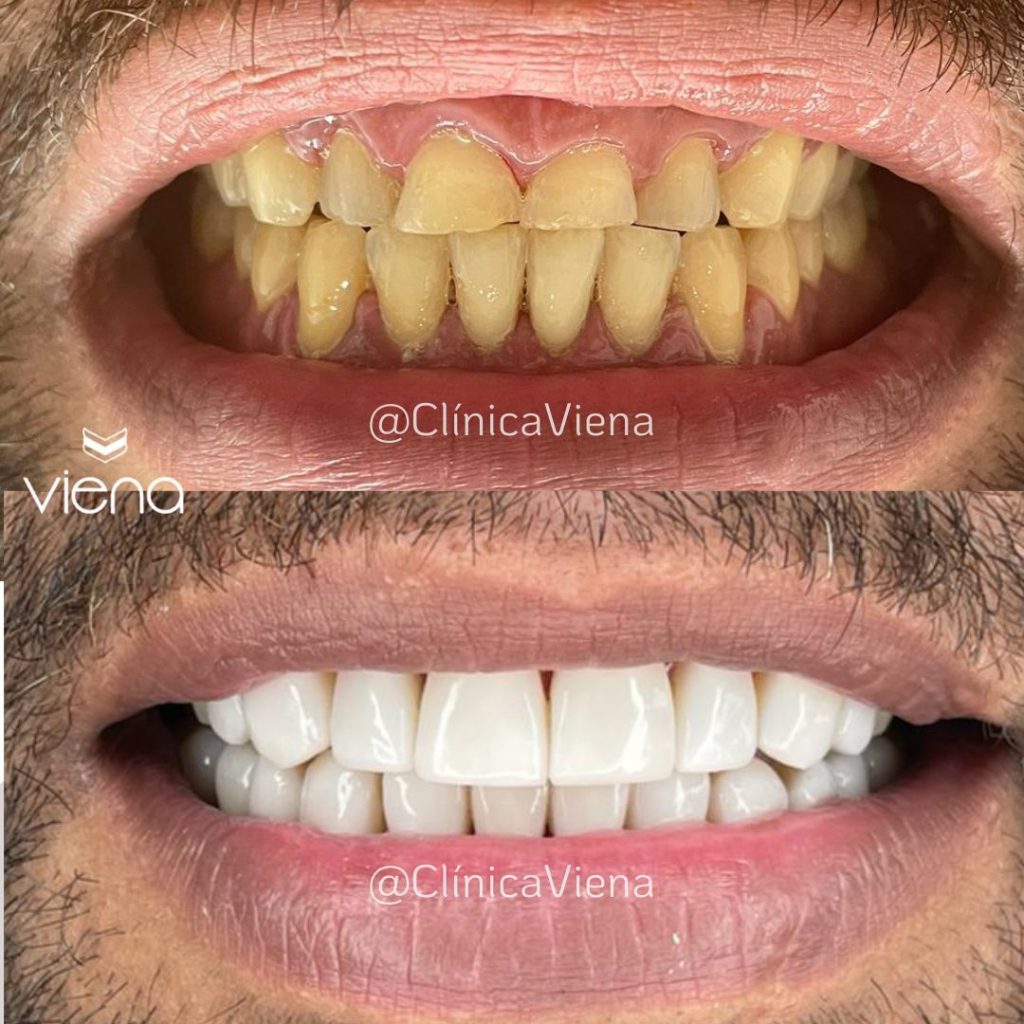
- Before: Chipped and stained teeth
- After: Smooth, white, and aligned smile

- Before: Gaps and uneven teeth
- After: Perfectly spaced and uniform teeth
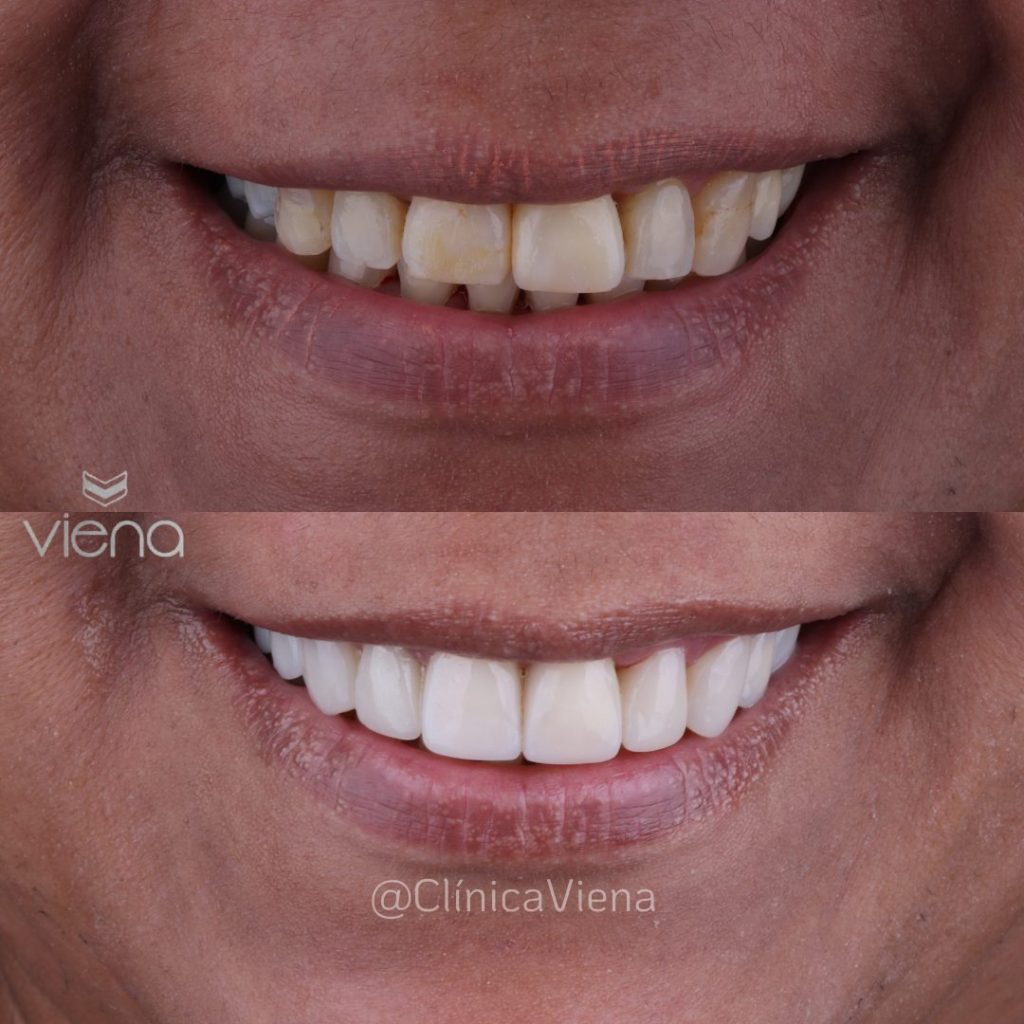
- Before: Worn and discolored teeth
- After: Natural-looking, bright smile
Dra. Sara Pelaez Monsalve
You might also be interested in:
Are Veneers Bad for Your Teeth? Risks, Myths, and Real Benefits
In the pursuit of a perfect smile, veneers have become...
Leer másDo Veneers Hurt? Expert Cosmetic Dentist’s Honest Answer
In the pursuit of a perfect smile, veneers have become...
Leer másHow Long Does a Dental Implant Take? Expert Dentist Answers
In the pursuit of a perfect smile, veneers have become...
Leer másWhy No Dairy After Dental Implant? What Science Really Says (2025)
In the pursuit of a perfect smile, veneers have become...
Leer más

